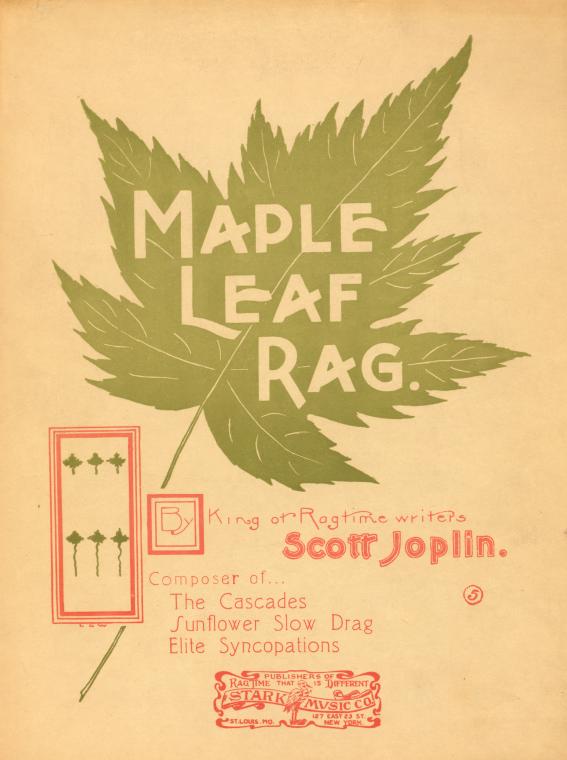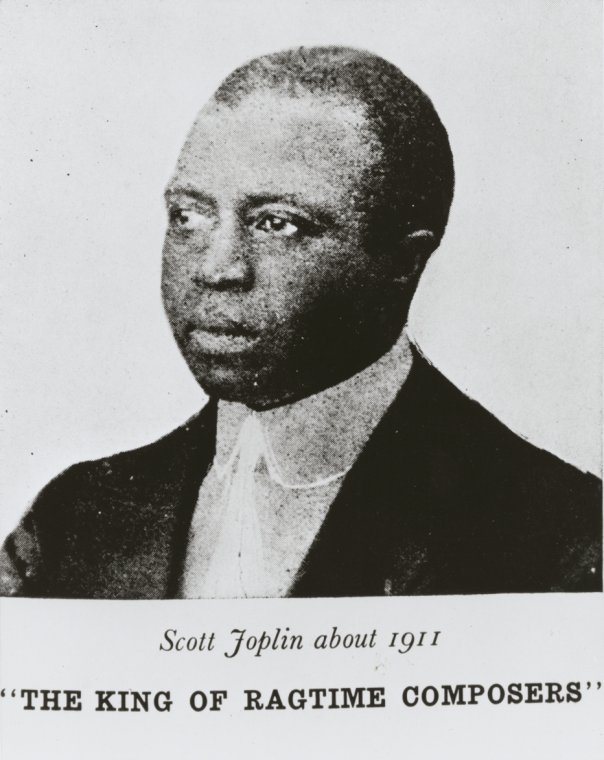Ragtime
Music that makes you want to move. “Happy Feet.” The syncopated rhythms evolved in red-light districts from New Orleans and St. Louis marches and jigs. They were originally intended to be dance music to but eventually grew and developed in complexity and orchestration to be almost symphonic. Ragtime was instrumental in bringing the music of African Americans to the attention of the entire country.
In the later 1800s the cakewalk was finding its way into Minstrel Shows and Vaudeville. It was, unfortunately, presented along racial lines and profoundly derogatory. There was, however, a wide general appeal to the syncopations and upbeat simple orchestration of piano or banjo. Like everything else in art that resonates culturally or aesthetically, it caught on. It was irresistible and more and more musicians took it on as a style and helped push it forward. The more hands that interpreted it, the more it took on a life of its own. It grew and evolved into Ragtime.
The name implied ‘ragged’ rhythms, referring to its bounce and syncopation. While the term ‘ragged-time’ or ‘ragtime’ also carried the image of poor blacks in rags, it took on an implication of blacks being musical. This image would help the spread of ‘jass music’ or Jazz later.
The most popular marches of the day were published by John Phillip Sousa and performed by bands all over the country. It was only a matter of time before several composers began to experiment with adding African American polyrhythms to the sophisticated orchestrations of the Sousa marches. Why not try to meld the two most popular forms of music of the day?
In the 1890s, there were only effectively two forms of music —published sheet music and piano rolls. The sheet music was frequently performed by the composer, creating the definitive performance as intended by the author. It was a great way to demonstrate how the written pieces were supposed to sound. Pianos equipped to play the roles were common and the piano roll industry was big business. In the years before radio (or any form of commonly available recorded music) most people were trained at a young age to read music. It was a primary form of polite interaction. Most houses of the day had a music room and were equipped with numerous instruments. The piano, violin, mandolin, guitar and banjo were among the most popular. Published sheet music was, therefore, very big business. People were keenly interested to get their hands on the latest popular music and be able to play it well for their friends. Playing it well meant playing it right, as it was intended to be played. Piano roles helped this concept as they demonstrated exactly what the author had in mind.
Written music is not improvised. This may sound obvious, but we have entered a different age. Most people today are not classically trained, do not read music fluently and yet many still learn to play instruments by ear. We celebrate new interpretations of old melodies and our current mode of thinking supports improvisation as an art form. This was not the conception of the average American at the turn of the 20th century.
In 1895 black entertainer Ernest Hogan (Ernest Reuben Crowders 1865-1909) published 2 of the earliest rags captured on sheet music. Hogan was an actor and Broadway producer as well as a composer. One of the rags “All Coons Look Alike To Me” eventually sold millions of copies. What Hogan had actually done was to capture the rhythm of what the non-reading black musicians of the day were playing. The tune had a wonderful impact of bringing the polyrhythms to the broader American public but the downside of starting a genre that would come to be known as ‘Coon Songs.’
Ernest Hogan
In 1899 Scott Joplin (1867-1917) published the ‘Maple Leaf Rag’. American music would never be the same.
Scott Joplin
Joplin was born in Texarkana Texas as a member of the first post-slavery generation. He was a gifted musician from a very young age with a passion for the piano. He absorbed all the musical influences around him including Gospel Hymns and Spirituals, plantation songs, dance hall music, blues, marches, jigs and choruses. A classically trained music teacher and German immigrant by the name Julius Weiss discovered the boy at age 11 and was sufficiently impressed with his talent that he chose to train him free of charge. He brought Joplin an appreciation of classical keyboard technique and exposure to European musical styles from folk to opera.
Scott Joplin
Over the course of his brief life, he composed 44 original ragtime works, one ragtime ballet, and two operas. Joplin approached music as a discipline. Compositions were assembled as finished pieces – fully orchestrated and polished. They were not conceived as improvisational works with room for individual interpretation. Rags were, in their own way, equal in sophistication and compositional complexity to any other Classical work – and equally ridged in the intended performance technique. They did, however, beautifully capture the broad wave of American influences of the day. In all their compositional complexity, they still had the toe-tapping touch of the common man. They were wildly successful in sheet music form.
World War I had a profound impact on America. It changed the way we perceived ourselves and the world around us. More than 15 million people had died and the map of the world as we had known it was entirely redrawn. Old powers were gone and new ones emerged. Like other times of major change, the desire for a new art form rose from the ashes of the aftermath. The music from before the war did not feel appropriate as an expression of the times anymore. The public had changed and looked for a new music to reflect those changes. Joplin died one year before the war ended and his music almost died with him.
Over the years there were a few revivals of ragtime, but nothing really stuck until the 1970s. Three events occurred that brought Ragtime back to the public consciousness:
In 1971 Pianist Joshua Rifkin assembled a compilation of the works of Scott Joplin and released them in LP record form for Nonesuch Records. It was nominated for a Grammy award in the ‘Best Classical Performance – Instrumental Soloist without Orchestra’ category. The performances were delivered true to Joplin’s intentions.
The New York Public Library released a two-volume set of ‘The Collected Works of Scott Joplin.” This work helped bring Joplin’s music to the attention of current musicians.
In 1973, the film The Sting was released with a soundtrack of Joplin’s tunes played by Marvin Hamlish. This brought the Joplin rag ‘The Entertainer” to the widest audience yet as the tune ranked as a Top 40 hit in 1974. The film also received an Academy Award.
Ragtime is uniquely American.
If you would like to use content from this page, see our Terms of Usage policy.
© 2009 Leonard Wyeth






